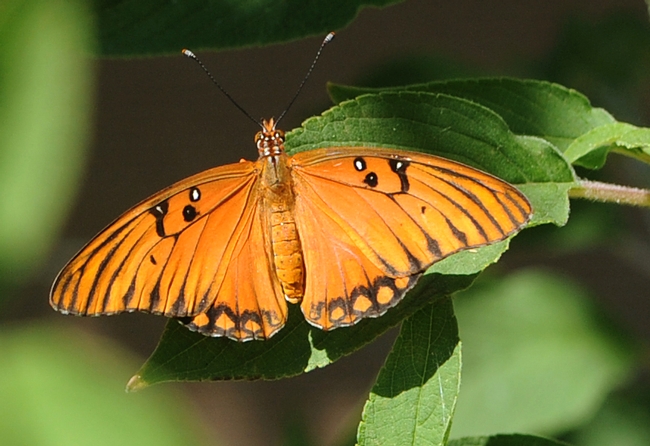It's showtime!
The Gulf Fritillary butterfly is one of the showiest butterflies in California, says butterfly guru Art Shapiro, professor of evolution and ecology at UC Davis.
Indeed it is.
The bright orange-red butterfly with a wingspan that can reach four inches visited our back yard yesterday. It nectared the lantana and sedum, competing for the sweet treats with honey bees, sweat bees and leafcutting bees.
Last year we planted a passionflower (Passiflora) vine (larval host of the Gulf Fritillary). None came. No butterflies, no breeding site, no little orange-and-black caterpillars to chew the passionflower leaves. We removed the vine and replaced it with vegetables.
The Gulf Fritillary (Agraulis vanillae) is even more beautiful when it folds its wings. Then you can see what makes this butterfly so utterly breathtaking: the iridescent silvery spots.
Shapiro says this is a tropical and subtropical butterfly, with a range extending from the southern United States all the way to central Argentina. It appeared in southern California in the late 1800s, and was first recorded in the San Francisco Bay Area around 1908.
Like to attract this butterfly? Its larval hosts include passionflower vines, such as the maypop (Passiflora incarnata), blue passionflower (P. caerulea), and corky-stemmed passionflower (P. suberosa). As an adult, it nectars on such plants as lantana (Lantana camara), tall verbena (Verbena bonariensis), pentas (Pentas lanceolata), drummond phlox (Phlox drummondi) and something called "tread softly" (Cnidosculous stimulosus).
"Tread softly" is also a good idea if you're trying to photograph it. It's a very skittish butterfly and the slightest movement will prompt it to take off.
But if you wait patiently, the fluttering orange flash will likely return.
Attached Images:

Close-up Gulf Fritillary on sedum. (Photo by Kathy Keatley Garvey)

Wingspan of Gulf Fritillary (Agraulis vanillae) can reach four inches. (Photo by Kathy Keatley Garvey)

Leafcutter bee heads for the same nectar spot as the brilliant Gulf Fritillary. Note the iridescent silverly spots. (Photo by Kathy Keatley Garvey)